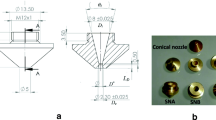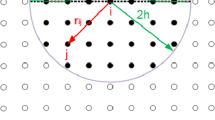Abstract
Based on Navier-Stokes equation and renormalization group (RNG) onflow model, the 3D symmetrical impinging jet model of laser cutting is established by adopting a taper nozzle and a convergence nozzle. Numerical simulation of gas flow in laser cutting is used to investigate the effect of workpiece thickness on flow field of assist gas in cutting slot. The isolines of static pressure as well as the distributions of static pressure and velocity are analyzed in details with different workpiece thickness, and the trend of dynamics characteristics of gas jet is shown in the study. For taper nozzles and convergence nozzles, the dynamic structure of assist gas being close to the lower surface of workpiece is exacerbated while the cutting quality and cutting efficiency become worse with the increasing of workpiece thickness. The parallel degree between assist gas and the axis of convergence nozzle is better than that of taper nozzle after the gas goes out of the nozzles. Two typical subsonic nozzles are designed for the cutting experiment at the end of the paper.
Similar content being viewed by others
References
Yilbas B S. Laser cutting quality assessment and thermal efficiency analysis [J]. Journal of Materials Processing Technology, 2004, 156(1): 2106–2115.
Karasev V A, Galushkin M G, Golubev V S, et al. Influence of basic parameters of metal cutting with gas laser on process energy efficiency [J]. Proceedings of SPIE-The International Society for Optical Engineering, 2005, 5777(2): 864–873.
Guo Shao-gang, Hu Jun, Luo Lei, et al. Analysis of assist gas flow and the structural optimizing for simple supersonic nozzle in laser fusion cutting [J]. Chinese Journal of Lasers, 2007, 27(5): 403–407 (in Chinese).
Yudin P V, Petrov A P, Kovalev O B. Experimental modeling and high speed photographic studies of gas laser cutting of sheet metal [J]. Proceedings of SPIE, 6279: 1–11.
Duan J, Man H C, Yue T M. Modeling the laser fusion cutting process. I. Mathematical modeling of the cut kerf geometry for the laser fusion cutting of thick metal [J]. Journal of Physics D, 2001, 34(14): 2127–2134.
Duan J, Man H C, Yue T M. Modelling the laser fusion cutting process. II. Distribution of supersonic gas flow field inside the cut kerf [J]. Journal of Physics D, 2001, 34(14): 2135–2142.
Duan J, Man H C, Yue T M. Modelling the laser fusion cutting process. III. Effects of various process parameters on cut kerf quality [J]. Journal of Physics D, 2001, 34(14): 2143–2150.
Cihan K, Omer K, Ibrahim U, et al. Laser cutting of steel sheets: Influence of workpiece thickness and beam waist position on kerf size and stria formation [J]. Journal of Materials Processing Technology, 2006, 172(1): 22–29.
Quintero F, Pou J, Fernandez J L, et al. Optimization of an off-axis nozzle for assist gas injection in laser fusion cutting [J]. Optics and Lasers in Engineering, 2006, 44(11): 1158–1171.
Kovalev O B, Yudin P V, Zaitsev A V. Formation of a vortex flow at the laser cutting of sheet metal with low pressure of assisting gas [J]. Journal of Physics D, 2008, 41(15): 104–112.
Yakhot V, Orszag S A, Thangam S, et al. Development of turbulence models for shear flows by double expansion technique [J]. Physics of Fluids A, 1992, 4(7): 1510–1520.
Yakhot V, Orszag S A. Numerical simulation of turbulent flow in the inlet region of a smooth pipe [J]. Journal of Scientific Computing, 1993, 8(2): 111–121.
Hu Jun, Guo Shao-gang, Luo Lei, et al. Dynamic characteristic analysis of impinging jet in laser drilling [J]. Chinese Journal of Lasers, 2008, 35(8): 1250–1254 (in Chinese).
Author information
Authors and Affiliations
Corresponding author
Additional information
Foundation item: the “Climbing” Program from Shanghai Science and Technology Development Fund (08111100802)
Rights and permissions
About this article
Cite this article
Hu, J., Sheng, Xj. & Luo, Jw. Numerical analysis and experimental study of the effect of workpiece thickness on flow field in laser cutting. J. Shanghai Jiaotong Univ. (Sci.) 15, 676–683 (2010). https://doi.org/10.1007/s12204-010-1068-1
Received:
Published:
Issue Date:
DOI: https://doi.org/10.1007/s12204-010-1068-1




